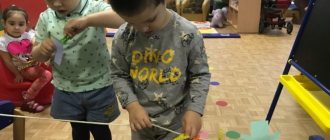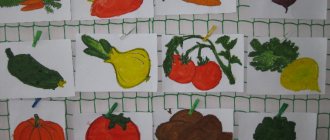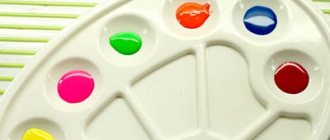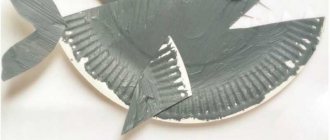Article “Drawing with young children”
Drawing with young children
Our main task in teaching drawing to the youngest children from 1 to 3 years old is to create conditions for the emergence of drawing, to support the child’s desire to draw, create, and explore. The most important thing in drawing is the child’s joy and pleasure from the process.
When we draw with the little ones, we can and should combine drawing with other activities of the child that evoke an emotional response in him - playing a musical instrument (for example, after drawing rain, you can play a rain melody on a metallophone), puppet theater (playing out a fairy tale - we drew a kolobok), a role-playing game (we drew candies for the doll and its guests).
Drawing is a truly educational activity for a child.
- Drawing is a sensory-motor exercise, the development of fine motor skills and sensorimotor coordination, i.e. natural, natural development of the child’s brain in activities that are interesting to him.
- Drawing is also the development of a child’s cognitive abilities.
- Drawing develops focused attention, because when drawing a child needs to complete the image, i.e. bring the job you started to completion.
- Drawing develops a child's imagination.
- Drawing is closely related to the development of children’s speech, because in the process of visual activity we conduct a conversation with the child, name color, shape, size, actions, and encourage speech.
Types of game drawing activities
1. Familiarization with the material, experimentation, study
A child's drawing does not begin with an image of a ball, a bird, a path or some other object from his life. It begins with the child experimenting with the material itself - paints or pencils - and learning the properties and qualities of paints .
Before drawing anything, it is important for your child to get acquainted with paints as an unusual new object - just move your finger with paint over a sheet of paper and learn that, as it turns out, paint leaves a mark on the paper! And these marks can be different - dots (we place our finger vertically), and stripes (we move our finger down the paper and get a “path”), and even squiggles of the most bizarre shapes! The baby first gets acquainted with a pencil as an object - he can roll it, try to make a ladder out of pencils or stand them vertically, deliberately drop them from the table and put them back on the table and drop them again, tear paper with a pencil, knock pencils like sticks against each other.
Such examination activities cannot be prohibited for a child. On the contrary, we need to encourage them and support the child’s cognitive actions. Usually the child goes through this first “examination” stage from 1 year to 2 years. The sooner a pencil or paint falls into his hands, the sooner this stage will end. If a child's exploration needs are not met, he will not learn new techniques.
2. Watching an adult draw
You can draw in front of your child anything, any way, and with any materials. The adult tells the child what and how he draws.
For example: Look, now I’ll draw a bunny for you. What color will our bunny be - white or gray (the baby chooses). Okay, you and I will have a white bunny - white as a snowball! I'll take white paint. Where is our white paint? Here it is, right (the kid gave me a jar of the right color), I’ll dip my brush into the jar. Look carefully - I dip the brush not completely, but halfway. To take a little paint and so that it does not smear. Now I need to squeeze the brush against the edge of the jar. So that the excess paint flows into the jar - like this, drip-drip-drip-drip, the paint flows into the jar. Now everything is ready! Here is the bunny's head. The head is round like a ball. I’ll stroke the head with a brush and paint it: like this, like this, like this! (an adult paints over the outline of the head). It turned out to be a white head. Beautiful! What kind of ears does a bunny have? Long ones, that's right. Here is one ear that is long - long (the adult draws a line and simultaneously with the movement of the brush says “Long”), but the second ear is also long. And what kind of body does the bunny have - long or round (we look at the toy) - round like a ball. Now I'll paint over the body. Like this - I stroke the bunny with a brush. Top down, top down! She stroked the bunny's tummy. And he became white! Do you like the bunny's white belly? This is what the body turned out to be. Hey, bunny! What kind of tail does the bunny have - long or short? No, it's short. What does it look like? The tail is like a small ball. Hey bunny, bunny, jump. Our little bunny jumped around the forest - stomp, stomp, stomp. Do you want to jump? Take a brush and paint - stomp, stomp, stomp, stomp. the bunny is running. Smart girl! etc.
If the child does not yet speak, then this comment can be simplified and spoken in simpler, short sentences. For example, you draw marks on a path by dipping. Top-top-top-top, this matryoshka went for a walk along the path. Or jump-jump-jump-jump, a bunny jumped through the snow. Or drip-drip-drip-drip - it’s raining from a cloud. “Vzhzhzhzhzhzhzh” (draw a long horizontal line from one edge of the sheet to the other) - a car drove by.
3. Free drawing for kids
Children draw themselves what they want, how they want and as much as they want. Our task is to provide them with a creative environment for this (for example, cover the table with oilcloth or lay film on the floor), provide paints, pencils, and crayons. And after drawing, together with the child and with his possible help, restore order and put everything back in place.
It should be taken into account that the “average” child aged 1 to 3 years usually begins to get tired after 10-15 minutes of any activity in a sitting position, including drawing. Therefore, if you see signs of fatigue, you can switch your baby to something else.
4. Mastering drawing techniques together with an adult through game situations
The child draws something specific together with an adult. An adult helps and guides, sets a game plot, shows the child drawing techniques, the correct grip of a brush and pencil with his fingers, etc.
But it is important to understand that any child from 1 to 3 years old will not be happy to complete educational drawing tasks (draw grass, rain, balls, etc.) if he does not understand why he needs it? Therefore, any drawing lesson with a child is always a playful activity. Therefore, our plot can unfold like this: a bunny comes running to us from the forest. He is upset and cannot pick carrots from the garden. The green tails are not visible, the carrots cannot be pulled out. Let us help you draw the tails for the carrots.
Don't forget about the algorithm for mastering new skills. For example, we want to teach a child to draw vertical lines.
- On Monday we will draw rain.
- On Tuesday, my child and I will draw green grass or ribbons for dolls (these are also vertical lines).
- Then you can take a break for a few days if you don’t want to draw or have other plans.
- On Friday or Saturday we will again draw vertical lines with the baby to consolidate the skill. But this time we need a different game plot. For example, this will be a fence for a rooster - the kid will draw a fence to hide the toy from the fox.
You can use different materials for drawing with young children:
- Brushes (the brush can be cut) and paints (gouache, watercolor, icing for decorating cookies with food coloring or natural berry dyes),
- bright soft colored pencils,
- crayons (wax and regular),
- oil pastel (short)
- felt-tip pens (both felt-tip pens for paper and felt-tip pens for fabric),
- Finger paint,
- pieces of sponge (you can cut them in different sizes and shapes),
- pieces of cotton wool (cotton balls, cotton swabs) as stamps - signets for a pattern of round shapes,
- brushes (“poke the brush with a poke” and get an interesting texture, similar to a dandelion or fluff or animal fur),
- stamps for children - signets (ready-made sets of stamps for children with stamp inks),
- In recent years, gel pens, watercolor pencils, colored ballpoint pens, and colored ink have also begun to be used in drawing with children.
With young children you can use quite a variety of drawing methods. For example:
- poke drawing,
- dip painting,
- drawing with stamps
- drawing lines (vertical and horizontal),
- drawing circular lines,
- finger painting - fingerprints on paper
To paint with a poke, you will need a semi-dry hard brush made of bristles and paint. When painting with a poke, the brush is held vertically. The shorter the bristle brush, the more expressive the texture of the print on the paper. Therefore, if you have a long brush, then trim the lint on it in advance. The brush should be large enough so that the “poke” turns out to be large. For this type of painting we use thick paint, usually gouache paint. The brush should not be wet.
Examples of subjects for drawing with a poke
:
- Prints of yellow or white color on a green background - dandelions in a meadow,
- White prints on the blue sky are fluffy clouds,
- The blue brush marks are raindrops coming from a cloud.
- Yellow, orange, red prints drawn by a child on a background of autumn trees prepared by you in advance are autumn foliage,
- If a child draws white prints on a winter background all over a sheet of paper, they will get fluffy snowflakes.
- Against the background of the city and the black sky using the poke technique, multi-colored fireworks in the sky look very beautiful
Dipping
is a method of painting with a brush, with which you can get a rather interesting image without artistic skills. You will need paints - gouache. as well as a “Squirrel” brush for painting. The brush should be soft and leave a fairly large impression.
We put paint on the brush and touch the bristles of the brush to a sheet of paper. It turns out to be a fingerprint.
Using such prints you can get different images:
- traces of animals on a white background of snow in the forest,
- lights are burning in the house (we apply it - we draw “windows” on the outline of the house, prepared in advance by an adult),
- the lights are lit on the New Year tree (the green outline of the tree is prepared in advance by an adult),
- leaves on a tree branch (the adult draws the branch, the child only draws the leaves),
- bugs in the grass,
The stamp that leaves an imprint on the paper can be a foam sponge, a cotton swab, or the child’s own finger. Stamps of different shapes can also be cut from vegetables, such as potatoes or carrots.
What can you draw with stamps:
- multi-colored cubes (we make prints on paper with cubes from the designer-builder),
- rowan berries on a branch,
- beads,
- lights on the New Year tree,
- stars in the sky,
- caterpillar,
- apples on an apple tree,
- pattern on the outline of an object, postcard
Sequence of play activities for 2-year-old children in learning to draw
Stage 1. We teach a 2-3 year old child to draw vertical lines with a brush and pencil
What topics and plots on drawing vertical lines with a pencil and brush can we offer a child:
- We draw a fence for the cockerel (we will hide the cockerel from the fox),
- We draw how green grass grows in a meadow with movements from top to bottom,
- Rain drips from a cloud onto the meadow and flowers: drip-drip-drip-drip,
- We draw a railway for a train,
- Let's draw strings for the balloons,
- We draw the hedgehog's spines.
- The rabbits' cleaning brush broke. Let's help fix it
Stage 2. Learn to draw horizontal lines with a pencil and brush
Horizontal brush movements can be offered to a 2-3 year old child in the following scenarios:
- thread from a ball,
- paths and paths,
- the car is driving along the road,
- ribbons,
- a lot of colored pencils are in a box
- a multi-colored rug for a cat (the image of a cat is cut out in advance by an adult and pasted onto a striped rug that the child made).
- handkerchief (the child paints horizontal lines on a sheet of paper or a piece of fabric stretched over a frame).
Stage 3. We draw circles and ovals with kids 2-3 years old
Typically, children are able to master circular movements from the age of 2.5 years, and we do not offer them such tasks before this age.
Ideas for game activities for learning to draw circles and ovals:
- balls for kittens (“wind the threads around a ball”),
- draw the sun and its rays,
- delicious sushi or bagels for grandma or another character,
- “stir the porridge” (Magpie – crow),
- snowball,
- snowman,
- balls,
- wheels for cars, for toy carts,
- tumbler,
- chick,
How to teach coloring
– first we hide something, paint it over. We gradually help the child reduce the range of movements. We paint over the object against a dark background, so the work will look more neat. When a child paints a round shape, you can remind him how to do it correctly. It’s as if we are “winding a thread around a ball.” This is necessary so that the baby learns to paint over the image using movements according to the shape of the object - in a circular manner.
It is very important that during educational game drawing sessions there are no distracting objects near the baby. For example, if you need only 4 paints for drawing, we only prepare them and put them on the table, we put away the other paints so that the child does not see them and cannot reach them. If we only need one paint, then we take out exactly this color of paint, and do not put the rest on the table.
Do not rush to teach your child, from the age of 2, intentional imagery and “stamps and patterns” in it - “this is how you should draw a bunny, and this is how you should draw a horse!” Do as I do. This is correct, but the way you drew it is wrong.” This age has another more important task!
Of course, we always give a positive assessment to any child’s drawing.
There are three important points here.
First. If the child made a drawing on the instructions of the toy, then the toy itself evaluates the work (for example, the bunny “accepts” the carrots he drew from the baby and thanks the child for them),
Second. If you need to correct something in a child’s drawing, we also do it in a playful way.
For example:
- WRONG: An adult says: “Your sunshine turned out well. Where are the rays? Forgot to draw again? I told you that I need to draw more rays, but you forgot.” After such an assessment, the baby will no longer have the desire to draw.
- CORRECT: An adult or a fairy-tale hero says: “Oh, you got the sunshine! What a round, yellow, warm thing. Well, I’ll stretch out my hands to him and bask in the sun. It's so warm! And warm yourself up. Oh, why did the sun hide its rays behind the clouds? Scared of us. Don't be afraid of us, sunshine. Show us the rays. Let’s help the sun show us its rays - let’s draw them like this!” and finish drawing the details that the baby forgot.
Third. Be sure to discuss his drawings with your child. Such a discussion encourages the baby to develop visual skills and creates a trusting relationship between mother and baby. If the drawing is successful, then, as a rule, adults do not have any difficulties. But if the drawing is completely incomprehensible to you. So what should we do?
Example 1. Your 2-year-old child brought you something incomprehensible in a drawing in the form of a circle, and says that it is his mother or grandmother (and many children draw adults this way). Don't be silent and don't be surprised. And immediately tell him: “What an interesting mother you have turned out to be!” Where is my hair? What about the eyes? Pens? Legs? Let the child complete the image with those details that he already knows well and that are available to him for depiction.
Example 2. Let's assume that your baby drew the same circle and brought you this drawing. But at the same time, he clearly doesn’t know what it is and what he depicted. In this case, you can and should start playing riddles with him and immediately ask him: “Did you draw a bun or a plate? Or maybe it's a bunny? Or the moon? All children love this game! Even if they were not going to wish you something, they immediately take on the role of the wisher and talk with you with pleasure. And so guess until your baby agrees that you “guessed” what he depicted.
The child has grown up - it’s time to complicate the drawing technique
Above, I talked about children from 8 months to 1.5 years, who are just beginning to learn the secrets of fine art. Ideally, they can already hold a pencil and brush correctly and know what to do with these objects. Children of this age can draw a line and distinguish several colors.
We've been here for 2-3 years now. It is necessary to complicate the tasks: in order to positively motivate the child to draw, I advise you to actively use nursery rhymes, poems, and fairy tales on various topics. Inspire children, create a good mood so that they have an irresistible desire to convey their impressions through drawing.
Pictures in sets on topics: house, animals, people will be very useful to you. We told a poem, showed an illustration, then we drew together. Invite your child to continue your drawing to begin with. So you wanted to portray Pinocchio, for example. You start with the head, the torso, the baby finishes drawing the nose, arms and legs.
It is important to talk to children, comment on your actions, thereby developing the speech and vocabulary of the little artist. As you already understood from my previous articles, everything that you and we do with children is aimed at their comprehensive development.
Drawing is also communication between the participants in the process. By not just putting a pencil in your child’s hand, you are developing the child. You need to actively participate in learning, come up with new techniques, motivate children, feel the lack of interest and be able to maintain persistent interest. Change materials - paint not only with gouache, but also with toothpaste, in general in different ways and techniques.
I described in detail non-traditional and traditional methods in articles under the “Drawing” section. With skillful organization of home activities, you can literally make your child fall in love with fine art for life. As a result, you will grow a non-standard personality, capable of creative solutions and creation.
What to draw with children? Here, just winter, is a fertile topic. We make fingerprints with white paint - that's snow for you. They crawled on the paper - and the snowman melted... The main thing is the desire of the parents to give the child everything necessary for the comprehensive development as a spiritual person.
Teaching your child to draw: where to start?
I have already written about early introduction to the fine arts, but the topic is so large and controversial that I will return to the question: at what age should we start teaching children to draw? In general, it’s worth saying that many parents don’t even realize that teaching any type of fine art or handicraft is mandatory. The children themselves will not figure out how to draw or cut or sculpt correctly, so that they can depict their plans.
You often hear from mothers: oh, my son can’t draw at all, he’s just like me. But, as practice shows, everyone can be taught to depict objects on paper. Children with insufficient development show wonderful results and talents. And healthy children can even master the intricacies of using a pencil and brush.
There are effective trainings even for adults, step-by-step lessons, master classes. If there was a desire... Another thing is that kindergarten teachers are not able to make an artist out of every child. We give basic skills to children, but parents must specifically develop their talents. Needless to say, long before kindergarten a child can master the basic wisdom of fine arts.
So, as soon as your baby begins to sit well, freely, firmly, you can offer to draw. The first step is up to you: if you are ready for paint stains on all surfaces, including the artist himself, use finger paints. Big Whatman paper to help you! Your task is to show your child what can be done with paint. Give one color first and show how you can draw a line on the paper with your finger. Look at the baby’s mood - at the first sign of loss of interest, switch your attention to something else. At this stage, it is important to arouse interest in drawing.
If you're not up for the extra work of scrubbing everyone and everything off the paint, work with a pencil or wax crayon. Start your fun lesson games right at the feeding table. Show your child how to hold a “tool” of work, how to draw a line correctly, etc.
As for the number of classes, do not overdo it, 1-2 times a week is enough.
Summary of educational activities in the early age group “Snowflakes”
Summary of educational activities in drawing in an early age group Natalya Sergeevna Sergeenko, teacher of MBDOU "Kindergarten No. 19 "Kapelka" of the city of Obninsk
Summary of educational activities for drawing “Snowflakes” (non-traditional drawing technique) with young children Goal: creating conditions for children’s creative activity. Objectives: - teach how to draw a snowflake in an unconventional way - with a cotton swab - clarify and supplement children’s knowledge about snow and its properties - develop play activities, cultivate friendly relations between children; -Expand words knowledge; -promote the development of children through finger gymnastics, play exercises, and outdoor play. Preliminary work: Observing seasonal changes in nature in winter, conversations about the characteristic signs of winter, reading poems about winter, looking at illustrations. Materials and equipment: Sheets of blue paper, white gouache, cotton swabs, a chest, a snowflake. NOD move: - Children, look outside the window, how much snow there is. Today I invite you to go on a trip to the winter forest to a forest clearing. Game exercise “Big feet walked along the road” (to music). Goal: Development of coordination of words and movements, work on tempo and rhythm. Hold hands and walk in a circle, sometimes slowly, loudly stamping your feet, sometimes speeding up and frequently moving your feet. Big feet Walked along the road Top-top, top-top Little legs Running along the path Top top top top top, Top top top top top Finger game - Bend one by one the left hand, starting with the little finger. The goal is to switch attention, improve coordination and fine motor skills. It is very cold in winter, but we will go for a walk with you. I’ll put on a fur coat, I’ll put on a scarf, And another scarf, And then I’ll put on beautiful, warm fluffy, crumbly mittens on my arms. - So we came to a snowy clearing. Quiet in the winter forest. Light, fluffy snowflakes swirl in the air and fall smoothly to the ground. You hear? I think someone is coming. Surprise moment (the teacher comes out dressed as a snowman) - Hello, guys! Did you recognize me? - I brought you a chest. And to find out what lies in it, guess the riddle: They fall from the sky in winter and circle above the earth. Light fluffs - White .... (snowflakes) Educator: - Snowman, and we know poems about snowflakes! Kids read poetry. A fluffy snowflake flew into our house and suddenly sat down on the decorated Christmas tree to rest.
The hedgehog looks into the sky: What kind of miracles are these? Hedgehogs fly in the sky, and if you take them in your hands, they melt. Hedgehogs White snowflakes. Snowman: -Children, look at my Snowflake! It is not simple, but magical, because it does not melt. Can you draw your own snowflakes for me? Kids: - Yes! Educator: Let's draw snowflakes for our guest. To draw beautiful snowflakes, you need to warm up your fingers. Finger game "Snowflake". A small snowflake landed on the palm (children show the snowflake) I’ll catch it, sit for a while (cover it with your palm) One, two, three, four, five (bend your fingers) I let it fly (blow on your palm) - You and I will not draw snowflakes with brushes , and with cotton swabs. You need to dip a cotton swab in white gouache and leave an imprint on the sheet (display on the board). Kids draw a snowflake with cotton swabs. Educator: Well done! The snowflakes for the snowman turned out great. Physical education Snowflakes are spinning (spinning on their toes) in the frosty air. Lacy stars fall to the ground. (slowly squat) One fell. (they catch the “snowflake” in the palm of their hand) Oh, don’t hide it, snowflake, (carefully “cover the snowflake” and blow it away) Wait a little. “Winter” Result: The teacher asks the children: -Did you like our trip? -Who came to us? -What did he bring us? -What did you draw? -What did you use to draw snowflakes? -What color are the snowflakes?
Let's talk about the misconceptions of some parents
From my observations and experience, I can note that some parents of newborn children go to two extremes: either they begin to actively engage in the development of the baby from the very first days, or they completely ignore the capabilities of children at an early age, hoping that in kindergarten teachers will fill in all the gaps.
The first type of mothers themselves collapse from fatigue and overload the child, trying to raise child prodigies, absolutely not taking into account the age-related physiological and emotional characteristics of newborns. The second type focuses on satisfying the natural needs of children, but misses valuable time for the development of the mental and emotional sphere.
1-3 years is a fertile period for laying the foundation for the child’s further growth in all directions. You need to understand that the golden mean in the approach to raising children is important: we begin to introduce them to the environment, develop the simplest skills, develop memory and thinking. This, of course, parallels physical development.
But everything should happen gradually, with joy and pleasure for both sides of the process - mother and child. We cannot imagine how sensitive newborn children are to the mood and emotional state of the mother. If the mother is irritated, tired, and works with the baby with force, then this will not bring any benefit to the child.
If you can’t plan your day in such a way as to find time for a fun, quiet 15 minutes of playing with your son or daughter with finger paints, for example, then it’s better not to bother. In a hurry and irritation, the result will be one negative thing and the baby will not want to draw for a long time, remembering how this activity irritated his mother.
The most correct and competent option is to plan activities before the baby is born. While on maternity leave, read methodological literature, draw up a schedule of games and activities for the first time, make an approximate daily schedule. You will already get used to the role of a good, calm and balanced mother. Of course, life makes its own adjustments to our plans and schedules, but planning greatly organizes a person, I know from my own experience.
Some more advice for concerned parents
Do you know what a big step in development for a baby is the first line on paper with a pencil? This is like man's first step in space, no less! A particularly valuable stage is when the child begins to “read” his drawing, moving from chaotic strokes to the same strokes, but meaningful. Kids depict many things in the same way - now it’s grass, now it’s a tree, now it’s an uncle.
Children of pre-Sadovo age perceive a drawn image as a real object or being. The change in doodles is directly related to changes in the psyche, its maturation. It’s not for nothing that psychologists work on children’s drawings, since this is a window into the world of a child who cannot express his experiences in words.
An adult plays a major role in a child’s life, so at an early age the main way to teach drawing and other types of creativity is demonstration. This means that you show and help your child draw. Move it with your hand and strengthen your motor skills. I repeat that we comment on all movements using auditory and visual memory.
Remember that at an early stage in children’s lives, the goals are: to arouse a strong interest in creativity and to instill skills in working with tools and materials. It is important to initially teach how to use the tools correctly, for their intended purpose, but gradually, as they grow older, to introduce new and non-standard techniques and materials.






